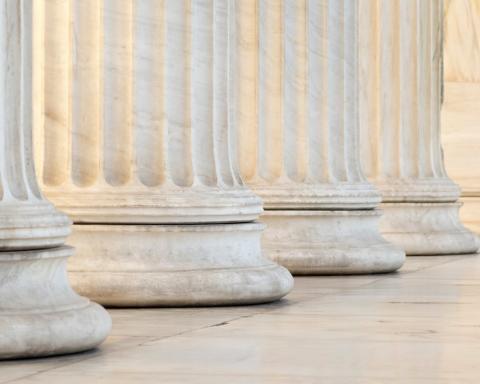This month's civil litigation discussion will focus on the United States Supreme Court's decision in Cooper Industries, Inc. v. Leatherman Tool Group, Inc., ___ U.S. ___, 121 S.Ct. 1678, No. 99-2035, 2001 WL 501732 (May 14, 2001) (Publication page references are not available for this decision).
In this decision, the Supreme Court determined what is the appropriate standard of review of a trial court's ruling on a challenge to the constitutionality of a punitive damage award.
In Cooper, the manufacturer of a multifunction hand tool sued a competitor for, inter alia, violations of the Lanham Act. Ultimately, the jury awarded the plaintiff $50,000 in compensatory damages and $4.5 million in punitive damages. Cooper, ___ U.S. at ___, 121 S.Ct. at ____. The district court rejected the defendant's contention that the punitive damage award was excessive under the guidelines set forth in BMW of North America, Inc. v. Gore, 517 U.S. 559 (1996)("Gore"). The Ninth Circuit reviewed the district court's finding that the award "was proportional and fair, given the nature of the conduct, the evidence of intentional passing off, and the size of an award necessary to create deterrence to an entity of Cooper's size." Cooper, ___ U.S. at ___, 121 S.Ct. at ____. The Ninth Circuit affirmed the punitive damage award concluding that the district court had not abused its discretion in declining to reduce the award.
In reversing the Ninth Circuit, the Supreme Court held that courts of appeals should apply a de novo standard when reviewing district court determinations of the constitutionality of punitive damage awards. The Supreme Court found that the Ninth Circuit erred when it applied an abuse of discretion standard to the district court's refusal to reduce the jury's punitive damage award. Id.
In reaching its decision on the standard of review applicable to constitutional challenges to the size of punitive damage awards, the Supreme Court began by distinguishing compensatory and punitive damages: "A jury's assessment of the extent of a plaintiff's injury is essentially a factual determination, whereas its imposition of punitive damages is an expression of its moral condemnation." Id.
The Court then noted that despite the broad discretion state legislatures enjoy in authorizing and limiting permissible punitive damage awards, the Due Process Clause of the Fourteenth Amendment imposes limits on that discretion. Specifically, the Fourteenth Amendment makes the Eighth Amendment's prohibition against excessive fines and cruel and unusual punishments applicable to the several States. The Court then enumerated several cases for the propositions that the Court has enforced the limits imposed by the Eighth Amendment in cases involving deprivations of life, liberty, and property. Cooper, ___ U.S. at ___, 121 S.Ct. at ____.
The Court recognized that the relevant constitutional line drawn in the sand by the Eighth Amendment is "inherently imprecise," but that the determination always focuses on the same three criteria: (1) the degree of the defendant's reprehensibility or culpability; (2) the relationship between the penalty and the harm to the victim caused by the defendant's actions; and (3) the sanctions imposed in other cases for comparable misconduct. Id. The Court then stated that in a prior case it had required a de novo review by a court of appeals at least with respect to the proportionality inquiry.
In further support of its decision, the Court analogized the review of excessive damage awards to determinations of "reasonable suspicion" and "probable cause." The Court stated that "the precise meaning of concepts like ˜reasonable suspicion™ and ˜probable cause" cannot be articulated with precision." Cooper, ___ U.S. at ___, 121 S.Ct. at ____ (citing Ornelas v. United States, 517 U.S. 690, 696-97 (1996)). Rather, the Court found that such concepts, including "gross excessiveness" of punitive damage awards, are "fluid concepts" which take their content from the contexts in which the standards are being assessed." Cooper, ___ U.S. at ___, 121 S.Ct. at ____ (quoting Ornelas v. United States, 116 S.Ct. 1657, 134 L.Ed.2d 911, 517 U.S. 690, 696-97 (1996)). The Court then reasoned that independent review by appellate courts is necessary if appellate courts are to "maintain control of, and to clarify, the legal principles." Id. The final support for the Court's opinion came in its statement that "'de novo review tends to unify precedent™ and ˜stabilize the law.'" Id.
After finding support for its holding that courts of appeal would apply de novo review to constitutional challenges to punitive damage awards, the Court addressed concerns about the results of its ruling. The Court first noted that the rights secured by the Seventh Amendment are not implicated because "the level of punitive damages is not really a ˜fact™ ˜tried™ by the jury." Cooper (quoting Gasperini v. Center for Humanities, Inc., 518 U.S. 415, 459 (1996) (Scallia, J., dissenting). The Court then tried to defuse the argument that the deterrent function of punitive damages suggests that the amount of such damages is a "fact" found by the jury: "juries do not normally engage in such a finely tuned exercise of deterrence calibration when awarding punitive damages."
In summary, Gore established three criteria to be used by courts evaluating a punitive damage award's consistency with due process. Cooper now assures that appellate courts will review any punitive damage award de novo when it is challenged on a constitutional basis. Through its ruling in Cooper, the Supreme Court has put teeth into its prior decision in Gore.








